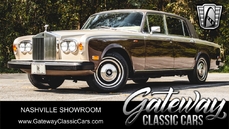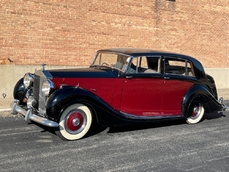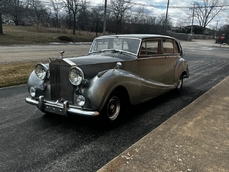Rolls-Royce Silver Wraith 1954
Allgemeine Beschreibung :
The Silver Wraith was Rolls-Royce’s first post-war offering, holding the distinction of being the first model built in the now legendary Crewe factory, which, to that point had served as the main production line for Merlin aero engines during World War II. In the spirit of the post-war recovery, Rolls-Royce started with a fresh slate for the new Silver Wraith. It would, as with the pre-war models, be the standard model, slotted below the ultra-exclusive, eight-cylinder Phantom IV. Unlike previous Phantom models, the Phantom IV was strictly reserved for royalty and heads of state, and just 18 would be produced, making it one of the rarest and most desirable models in Rolls-Royce history. Despite the fact that Rolls-Royce had this new inline-eight at their disposal, the Silver Wraith would be strictly limited to six-cylinder power. Both models would still be sold as bare chassis, and coachbuilders would share much of the Phantom IV’s stately elegance in the basic styling of the Silver Wraith, particularly on long-wheelbase versions, albeit on a somewhat less-exclusive scale.
This splendid 1954 Silver Wraith Long Wheelbase Saloon, chassis number CLW37, is a truly unique motorcar that features one-off coachwork by Freestone & Webb, and combines a proven Silver Wraith chassis with the prestige of a genuine Phantom IV engine. Thanks to the efforts of one passionate Rolls-Royce aficionado, this car has been professionally converted with what was likely the only spare Phantom IV inline-eight cylinder engine in existence. It is most recently out of a prominent American collection; a cherished and fabulous driver’s car with a fascinating history.
The story of this very special Silver Wraith begins in earnest in 1987 with Mr. John Donner, an Englishman who had long lusted after the rare and elusive Phantom IV. Given their scarcity and value, he accepted that it was unlikely he’d ever get to own one, so he decided to shift gears, so to speak, and take matters into his own hands by essentially building a P-IV of his own. Donner was alerted by a friend, Mr. Ken Steeley, managing director of Rolls-Royce dealer H.A. Fox in Torquay, England, to the availability of CLW37. Donner was able to acquire the car, soon discovering he was only the third owner of this desirable late-specification long-wheelbase Silver Wraith, and that it featured one-off “owner/driver” coachwork by Freestone & Webb. As found, the car was in a bit of a sad state, but it was otherwise complete and it would serve as the perfect basis for Donner’s dream project.
Next, Mr. Donner contacted his friend Ken Lea, who served as the Director of Engineering at Rolls-Royce in Crewe and was himself a passionate devotee of the marque. Donner and his friend Lea discussed a rumor that somewhere in the world existed a new Phantom IV engine, still in its crate. Amazingly, Ken soon reported back to John that he had not only confirmed the story, but that he had found the engine, untouched in private hands. According to Mr. Lea, six prototypes of the special P-IV inline-eight cylinder engine were built, all of which were ordered to be scrapped. At the last minute, however, one unit was put aside and rebuilt to be kept as a ready spare, should one of the Phantom IVs in royal service suffer an unexpected failure. Of course, this never happened, so the engine was crated and sold off in 1972. Mr. Stan Brunt had purchased the Phantom IV engine from the works in hopes of turning it into a stationary generator!
John Donner was able to secure ownership of this impossibly rare engine, sending it to Ken Lea at Rolls-Royce for inspection. It was found it to be in factory-new condition inside and out, and every component was carefully examined to determine that this was indeed, a genuine Phantom IV unit and not the more common B80 as used for military and commercial applications. Next, car and engine were handed over to John Dray who began the process of mating the two. Mr. Dray removed the original inline six, and rebuilt the original transmission with stronger internals to handle the additional power output of the eight. The process of fitting the engine was not simple, as the big eight is significantly longer than the original six-cylinder and required modifications to the bulkhead and propshaft. In the end, the mechanical conversion was exceptionally well-engineered, as proven by the car’s surprising performance and outstanding drivability. The incredible Phantom IV engine still presents beautifully under the bonnet, the installation looking like a factory effort, with only the additional two plug leads giving it away.
Once the heavy lifting of the mechanical work was completed, CLW37 was driven (briskly!) to the workshops of the legendary Rolls-Royce dealer, P&A Wood, where the coachwork was restored to a high standard. The project was completed in the early 1990s, and the car subsequently shown and enjoyed on numerous tours around England as well as the highly regarded RREC “Jewel that is Jordan” Tour in 1999.
The most recent owner has kept this remarkable Rolls-Royce in wonderful condition, now displaying a slight patina that is well suited to the character of the car. The Velvet Green paintwork is excellent, and the one-off coachwork straight and properly aligned. Intended for the owner-driver, the Freestone & Webb body features a sunroof and a beautifully appointed cabin without a division to allow for greater driver comfort. Rear passengers are treated to luxurious accommodations in the lush rear bench. Lovely older woodwork presents well with glossy lacquer, showing just a few minor cracks in the finish. The tan leather upholstery on the seats and door cards shows some very slight use but remains supple and in fine order. The cabin is smartly appointed with roller-blind sun visors for front seat occupants, picnic trays, and electric windows for all but the driver, as original.
While no doubt stylish and luxurious, the obvious highlight of this motorcar is its performance; with the editor of the RREC magazine describing it to be “of the true scalded cat variety”. The exceptional smoothness and torque of the Phantom IV power plant transforms the otherwise sedate Silver Wraith into a supremely fine long-distance touring car, and the unique one-off coachwork imparts a sense of occasion that mimics that of the highly exclusive genuine article. This is a uniquely individual labor of love that is sure to impress the most dedicated of Rolls-Royce connoisseurs as much as it will serious collectors and classic touring enthusiasts.
https://hymanltd.com/vehicles/6106
1954 Rolls-Royce Silver Wraith is listed verkauft on ClassicDigest in St. Louis by Mark Hyman for $160000.
Fakten der Auto
Karosserietyp : Auto Marke : Rolls-Royce Modell : Silver Wraith Hubraum : 0.0 Modelljahr : 1954 Lage : Missouri
Verkauft
Angaben Zum Verkäufer
Verkauft
People who viewed this Rolls-Royce Silver Wraith also viewed similar Rolls-Royce listed at ClassicDigest
Other cars listed for sale by this dealer
über Rolls-Royce
Nun, meine Damen und Herren, heute tauchen wir ein in die glanzvolle Geschichte einer Marke, die immer das ganz Wesen britischen Luxus und Handwerkskunst verkörpert hat - Rolls-Royce.Unsere Geschichte beginnt zu Beginn des 20. Jahrhunderts, als zwei Visionäre, Charles Rolls und Henry Royce, beschlossen, sich zusammenzuschließen. Im Jahr 1904 wurde der allererste Rolls-Royce geboren, der Rolls-Royce 10 hp. Es war ein bescheidener Anfang für ein Unternehmen, das die Automobil-Exzellenz neu definieren würde.
Aber es war erst 1907, dass Rolls-Royce wirklich seinen Stempel aufdrückte, mit der Einführung des Silver Ghost. Er wurde als das "Beste Auto der Welt" gefeiert und setzte den Goldstandard für Luxusautos. Mit seinem flüsterleisen Motor und seiner exquisiten Handwerkskunst war er ein Statement von Opulenz und Raffinesse.
Die 1920er Jahre brachten uns den Rolls-Royce Phantom I, ein Ikone seiner Zeit. Es war der erste Rolls-Royce mit einem 6-Zylinder-Motor und legte den Grundstein für die legendäre Phantom-Reihe. Dies war die Ära, in der die Maharadschas von Indien maßgefertigte Rolls-Royces in Auftrag gaben, die nichts weniger als automobilen Palästen entsprachen.
Schnell vorwärts in die Nachkriegsjahre, und wir haben den Silver Cloud, ein Symbol für den britischen Optimismus der Nachkriegszeit. Der Silver Cloud verkörperte Eleganz, mit seinen fließenden Linien und handgefertigten Interieurs. Er war die Wahl von Königen, Prominenten und Industriekapitänen.
Aber wenn wir über das Epizentrum des Rolls-Royce-Luxus sprechen, dann ist es der Rolls-Royce Phantom VI, der uns von 1968 bis 1991 begleitete. Dies war ein Auto, das die Aussage traf, dass "wenn Sie nach dem Preis fragen müssen, können Sie es sich nicht leisten." Anpassung war das Stichwort, und der Phantom VI war eine Leinwand für die weltweit Wohlhabendsten, um ihren einzigartigen Geschmack auszudrücken.
Nun, es ist unmöglich, über Rolls-Royce zu sprechen, ohne den Rolls-Royce Corniche zu erwähnen. Produziert von 1971 bis 1995, handelte es sich um eine Cabriolet- und Coupé-Version des Silver Shadow. Der Corniche war der Inbegriff des Grand Touring, ein Auto für diejenigen, die den Kontinent in absolutem Luxus durchqueren wollten.
Aber, ach, selbst die Mächtigsten müssen ihren Niedergang erleben, und Rolls-Royce war keine Ausnahme. Das Unternehmen durchlief in den 1970er und 80er Jahren finanzielle Turbulenzen, was zur Übernahme durch Vickers plc führte. Dann kam die umstrittene Eigentümerschaft von BMW und Volkswagen, die die Enthusiasten spaltete.
Rolls-Royce erlangte unter BMW-Besitz wieder Boden, und das neue Jahrtausend brachte uns den Rolls-Royce Phantom VII, eine Rückkehr zu den Wurzeln des Unternehmens für kompromisslosen Luxus. Der Phantom VII war ein Zeugnis für britische Ingenieurskunst und Handwerkskunst.
Und das, meine Damen und Herren, bringt uns auf den heutigen Tag. Rolls-Royce produziert weiterhin einige der opulentesten, maßgeschneiderten Fahrzeuge auf dem Planeten, ein Symbol für die britische Imperium, das mit der Zeit nicht verblasst ist. Der Geist von Sir Henry Royce und Charles Rolls lebt in jedem Auto weiter, das die Spirit of Ecstasy trägt, ein Zeugnis für das anhaltende Erbe der britischen Automobil-Exzellenz.











